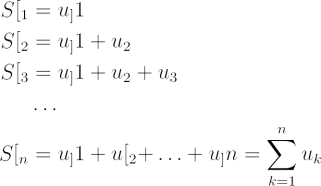Summation
The addition of a sequence of numbers can be represented with the summation symbol (Σ).
Consider an addition sequence, Sn. Suppose the numbers to be added are u1, u2, u3, …, un. We let
 |
The sigma (Σ) symbol represents a summation of n components. As n increases without bound…
![]()
…we are led to consider a summation over infinite components, which is denoted by
![]()
Such an expression is called an infinite series. As an example, we can write the equation of state for a mixture of gases:
| where P = total pressure | |
| Pi = partial pressures of all i gas species | |
| ni = particle number per unit volume | |
| k = Boltzmann’s constant, and | |
| T = temperature |
This equation describes the total pressure P, as the summation of partial pressures Pi.
Study Astronomy Online at Swinburne University
All material is © Swinburne University of Technology except where indicated.

